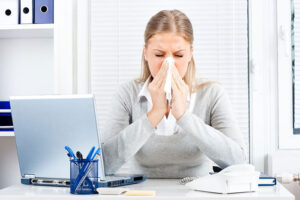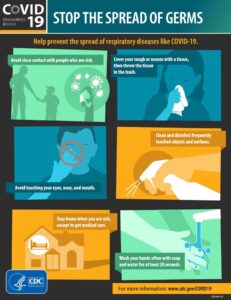Practices to Prevent Coronavirus at Work
- By Pia Hinckle
- Last Updated On
- Reading Time: 7 mins.
As concern over the spread of the Coronavirus (COVID-19) grows, what steps can you and your workplace take to stay healthy? Health officials say the best thing businesses can do is promote good hygiene practices for the regular cold and flu season—especially regular hand washing and letting employees stay home if they’re sick.

The U.S. Centers for Disease Control and Prevention (CDC) is monitoring both influenza (flu) season and the Coronavirus disease. The symptoms of the Coronavirus are similar to other upper respiratory infections, such as colds, bronchitis, and flu, and can include coughing, aches, fever, and shortness of breath. Severity has ranged from mild or no symptoms to acute respiratory illness and death.
Practice Good Hygiene & Be Prepared
“The severity of illness or how many people will fall ill from COVID-19 is unknown at this time. If there is evidence of a COVID-19 outbreak in the U.S., employers should plan to be able to respond in a flexible way to varying levels of severity and be prepared to refine their business response plans as needed,” wrote the CDC on its Interim Guidance for Businesses and Employers to Plan and Respond to Coronavirus Disease (COVID-19) on February 27, 2020.
“For the general American public, such as workers in non-healthcare settings and where it is unlikely that work tasks create an increased risk of exposures to COVID-19, the immediate health risk from COVID-19 is considered low. The CDC and its partners will continue to monitor national and international data on the severity of illness caused by COVID-19, will disseminate the results of these ongoing surveillance assessments, and will make additional recommendations as needed.”
4 Tips to Stay Healthy
While there’s still much to learn about the virus’ severity and transmissibility, the current recommendation is for individuals to take sensible precautions to stop the spread of germs.
1. Wash Your Hands
Always wash your hands before eating and after sneezing, coughing, going to the restroom, or shaking hands. Most people don’t wash their hands correctly. If there’s no water available, use a hand sanitizer with at least 60% ethyl alcohol (that’s what kills the germs), or antimicrobial towelettes.
- Wet hands
- Use soap and lather for at least 15-20 seconds
- Rinse
- Towel or air-dry hands
- Use a towel to turn off the faucet and open the door
2. Avoid Touching Your Face
Your nose, mouth, and eyes are easy entry-points for viruses to enter your body from your hands. Avoid touching your face and make sure you always wash your hands before you do.
3. Disinfect Surface Areas
Wipe down conference tables, shared keyboards, desks, and other communal surfaces with disinfecting wipes before use.
4. Cover Your Mouth
If you sneeze or cough, do so into a tissue, or into your elbow or shirtsleeve. This prevents germs from spreading to those around you. Throw away used tissues promptly. There are many other cold and flu viruses circulating right now besides Coronavirus. If you’re actively sick, stay home until you are symptom-free for at least 24 hours.
5. Review the CDC’s Information
Check out the CDC’s Personal Everyday Preventive Actions and do your part to stop the spread of the flu.
What Your Company Can Do to Prevent the Spread of the Coronavirus
The CDC is encouraging companies to:
- Be aware of the potential for stigma and discrimination in the workplace. Do not make risk determinations based on race or country of origin, but follow CDC guidance for how to conduct a risk assessment, and make sure to maintain the confidentiality of employees with confirmed COVID-19.
- Actively encourage all sick employees to notify their managers and stay home until they are symptom-free for 24 hours without the use of fever-reducing or symptom-relieving medicines.
- Review sick policies and ensure that they’re flexible and consistent with public health guidelines, and that employees are aware of them. Don’t require employees to submit a healthcare provider’s note during this time when clinics may be extremely busy.
- Review family leave policies to ensure flexibility for employees who may have to stay home to care for a sick family member.
- Send employees home if they show up sick or become ill during their workday.
- Educate employees about staying home when sick, cough and sneeze etiquette, and hand hygiene at the entrance to your workplace and in other high-visibility workplace areas.
- Provide tissues, alcohol-based hand sanitizer that contains at least 60-95% alcohol, hands-free trash receptacles, and encourage regular hand-washing.
- Regularly clean all frequently-touched surfaces, such as doorknobs, handles, workstations, remote controls, and countertops. No additional disinfection beyond normal cleaning routines is recommended at this time.
- Employees who travel for work should monitor the CDC’s Traveler’s Health Notices, monitor themselves for symptoms, and promptly notify their employer if they become ill.
What to Do If an Employee Is Exposed
- Employees who believe they may have been exposed to COVID-19 should follow these guidelines from the CDC, which include self-quarantine, wearing a mask, and seeing a doctor for diagnosis.
- Employees who are well but who have a sick family member at home with COVID-19 should notify their supervisor and refer to CDC guidance for how to conduct a risk assessment of their potential exposure.
- If an employee is confirmed to have COVID-19, employers should inform fellow employees of their possible exposure to COVID-19 in the workplace but maintain confidentiality as required by the Americans with Disabilities Act (ADA).
- Employees exposed to a co-worker with confirmed COVID-19 should refer to CDC guidance for how to conduct a risk assessment of their potential exposure.
Planning Considerations for Your Business
All employers should consider how best to decrease the spread of acute respiratory illness and lower the impact of COVID-19 in their workplace in the event of a widespread outbreak. They should identify and communicate their objectives, which may include one or more of the following: (a) reducing transmission among staff, (b) protecting people who are at higher risk because of adverse health complications, (c) maintaining business operations, and (d) minimizing adverse effects on other entities in their supply chains.
Consider:
- Monitoring the response and recommendations of state and local health authorities.
- Planning for possible increased numbers of employee absences.
- Cross-training personnel to perform essential functions.
- Preparing to change your business practices for a time, if needed, to maintain critical operations (e.g., identify alternative suppliers, prioritize customers, or temporarily suspend some of your operations if needed).
- Providing local managers with the authority to take appropriate actions outlined in their business infectious disease outbreak response plan (read further below for tips on how to make one if you don’t have one already) based on the condition in each locality.
How to Create an Infectious Disease Outbreak Response Plan
Employers should be ready to implement strategies to protect their workforce while ensuring continuity of operations. During a COVID-19 outbreak, sick employees should stay home and away from the workplace, respiratory etiquette and hand hygiene should be encouraged, and routine cleaning of commonly-touched surfaces should be performed regularly.
Ensure your plan is flexible and involve your employees in developing and reviewing your plan; explain to employees what human resources policies, workplace and leave flexibilities, and pay and benefits will be available; and share best practices with other businesses in your communities (especially those in your supply chain), chambers of commerce, and associations to improve community response efforts.
CDC Recommendations for an Infectious Disease Outbreak Response Plan:
- Identify possible work-related exposure and health risks to your employees. OSHA has more information on how to protect workers from potential exposures to COVID-19.
- Review HR policies and practices to ensure consistency with public health recommendations and existing state and federal workplace laws (for more information on employer responsibilities, visit the Department of Labor and the Equal Employment Opportunity Commission website).
- If state and local health authorities recommend the use of social distancing strategies, explore flexible worksites (e.g., telecommuting) and flexible work hours (e.g., staggered shifts). Ensure that you have the information technology and infrastructure needed to support multiple employees working from home.
- Identify essential business functions, essential jobs or roles, and critical elements within your supply chains (e.g., raw materials, suppliers, subcontractor services/products, and logistics) required to maintain business operations. Plan for how your business will operate if there is increasing absenteeism or if these supply chains are interrupted.
- Work closely with your local health officials to identify what conditions will trigger the activation of your company’s infectious disease outbreak response plan, including altering business operations (e.g., possibly changing or closing operations in affected areas) and transferring business knowledge to key employees.
- Communicate to employees, clients, and business partners your infectious disease outbreak response plans and latest COVID-19 information. Anticipate fear, anxiety, rumors, and misinformation, and plan communications accordingly.
- In some communities, early childhood programs and K-12 schools may be closed if COVID-19 worsens. Prepare to institute flexible workplace and leave policies for employees who have to care for children home from school.
- Local conditions will influence the decisions that public health officials make regarding community-level strategies; employers should take the time now to learn about plans in each community where they have a business.
- In the event of a COVID-19 outbreak in the U.S., consider canceling non-essential business travel per travel guidance on the CDC website.
- Remember that travel restrictions enacted by other countries could limit the ability of employees to return home if they become sick while traveling.
CDC Resources for more information:
- COVID-19 Website
- What You Need to Know About COVID-19
- What to Do If You Are Sick With COVID-19
- Interim US Guidance for Risk Assessment and Public Health Management of Persons with Potential Coronavirus Disease 2019 (COVID-19) Exposure in Travel-associated or Community Settings
- Health Alert Network
- Travelers’ Health Website
- National Institute for Occupational Safety and Health’s Small Business International Travel Resource Travel Planner
- Coronavirus Disease 2019 Recommendations for Ships
Pia Hinckle is publisher at The FruitGuys. This report was based on CDC guidelines current as of February 27, 2020. Not intended as medical advice. Consult you local health authorities for up to date guidelines.
Recent Articles
How Managing Less Helps Employees Take the Lead
Why Employee Appreciation Gifts Matter in 2025
Healthy Employee Appreciation Gift Ideas for Workplace Wellness
Sugar Is Out, Protein Is In: What’s Trending In Corporate Snacks
When Are Oranges in Season? A Guide to Top Varieties
Subscribe to our Newsletter
"*" indicates required fields




